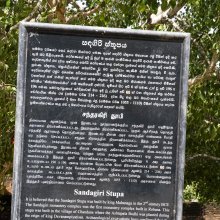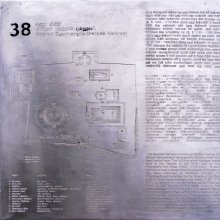Mun, Muṇ, Muṉ: 11 definitions
Introduction:
Mun means something in Hinduism, Sanskrit, the history of ancient India, biology, Tamil. If you want to know the exact meaning, history, etymology or English translation of this term then check out the descriptions on this page. Add your comment or reference to a book if you want to contribute to this summary article.
Images (photo gallery)
(+1 more images available)
India history and geography
Source: archive.org: Glossary of Sinhalese Folk Terms appearing in the Service Tenure RegisterMun:—A sort of pea forming one of the chief products of a hena, and largely used as a ourry.

The history of India traces the identification of countries, villages, towns and other regions of India, as well as mythology, zoology, royal dynasties, rulers, tribes, local festivities and traditions and regional languages. Ancient India enjoyed religious freedom and encourages the path of Dharma, a concept common to Buddhism, Hinduism, and Jainism.
Biology (plants and animals)
Source: Wisdom Library: Local Names of Plants and DrugsMun [মুন] in the Manipuri language is the name of a plant identified with Acrocarpus fraxinifolius from the Caesalpiniaceae (Gumohar) family. For the possible medicinal usage of mun, you can check this page for potential sources and references, although be aware that any some or none of the side-effects may not be mentioned here, wether they be harmful or beneficial to health.
Source: Google Books: CRC World Dictionary (Regional names)Mun in India is the name of a plant defined with Vigna radiata in various botanical sources. This page contains potential references in Ayurveda, modern medicine, and other folk traditions or local practices It has the synonym Phaseolus trinervius Wight & Arn. (among others).
Example references for further research on medicinal uses or toxicity (see latin names for full list):
· Japanese Journal of Botany (1955)
· Flora Indica (1832)
· Bull. Nat. Sci. Mus. (1953)
· Journal of Economic and Taxonomic Botany (1985)
· J. Wuhan Bot. Res. (1998)
· Bull. Appl. Bot. Gen. Pl. Breed. (1982)
If you are looking for specific details regarding Mun, for example chemical composition, diet and recipes, health benefits, extract dosage, side effects, pregnancy safety, have a look at these references.

This sections includes definitions from the five kingdoms of living things: Animals, Plants, Fungi, Protists and Monera. It will include both the official binomial nomenclature (scientific names usually in Latin) as well as regional spellings and variants.
Languages of India and abroad
Sanskrit dictionary
Source: DDSA: The practical Sanskrit-English dictionaryMuṇ (मुण्).—6 P. (muṇati) To promise.
Source: Cologne Digital Sanskrit Dictionaries: Shabda-Sagara Sanskrit-English DictionaryMuṇ (मुण्).—r. 6th cl. (muṇati) To vow or promise.
Source: Cologne Digital Sanskrit Dictionaries: Benfey Sanskrit-English DictionaryMuṇ (मुण्).—i. 6, [Parasmaipada.] To promise.
Source: Cologne Digital Sanskrit Dictionaries: Monier-Williams Sanskrit-English DictionaryMuṇ (मुण्):—[class] 6. [Parasmaipada] muṇati, to promise, [Dhātupāṭha xxviii, 44.]
Source: Cologne Digital Sanskrit Dictionaries: Yates Sanskrit-English DictionaryMuṇ (मुण्):—(śa) muṇati 6. a. To vow.
Source: DDSA: Paia-sadda-mahannavo; a comprehensive Prakrit Hindi dictionary (S)Muṇ (मुण्) in the Sanskrit language is related to the Prakrit word: Muṇa.
[Sanskrit to German]
Sanskrit, also spelled संस्कृतम् (saṃskṛtam), is an ancient language of India commonly seen as the grandmother of the Indo-European language family (even English!). Closely allied with Prakrit and Pali, Sanskrit is more exhaustive in both grammar and terms and has the most extensive collection of literature in the world, greatly surpassing its sister-languages Greek and Latin.
Kannada-English dictionary
Source: Alar: Kannada-English corpusMun (ಮುನ್):—
1) [adjective] being in or coming from front side.
2) [adjective] following the present; yet to come; future.
3) [adjective] happened in, relating to the initial stage.
4) [adjective] of times long past; ancient.
5) [adjective] moving towards prosperity; tending to improve or aiming at a higher state, condition or status.
6) [adjective] of, at or in the rear.
--- OR ---
Mun (ಮುನ್):—
1) [noun] the area, portion, region facing something.
2) [noun] that which follows the present or yet to come.
3) [noun] the beginning.
4) [noun] anything from or belong to ancient times.
--- OR ---
Mun (ಮುನ್):—
1) [adverb] in front; to or towards front.
2) [adverb] at a later time; after some time; subsequently.
3) [adverb] in the beinning; initially.
4) [adverb] in the past.
--- OR ---
Mun (ಮುನ್):—[noun] (in comp. only) three.
Kannada is a Dravidian language (as opposed to the Indo-European language family) mainly spoken in the southwestern region of India.
See also (Relevant definitions)
Starts with (+1289): Mamdamopi, Monemuri, Mu-nurrunalu, Mudi, Mumca, Mumcacu, Mumce, Mumcekade, Mumcisu, Mumcittu, Mumcu, Mumculi, Mumcuni, Mumcutu, Mumdadeyidu, Mumdadi, Mumdadu, Mumdagalli, Mumdagi, Mumdagu.
Ends with (+27): Aab jamun, Amun, Aulne commun, Avena comun, Avenca-comun, Bhui jamun, Bulu timun, Cacao comun, Dhamun, Emanimun, Emmun, Guama comun, Gul-e-mamun, Gul-e-meymun, Gulab jamun, Gulab-jamun, Gulajamun, Hierba guinea comun, Iharemun, Ikkew-kar-mun.
Full-text (+202): Munna, Munnilaval, Munmaram, Muncakkiratai, Munnorri, Munneru, Munpuruvam, Munpirantal, Emmun, Mumkattu, Munnura, Munnataippan, Munmati, Munmalai, Matai-muntotti, Munmurunkai, Munpani, Munmurukku, Munkai, Munnelucci.
Relevant text
Search found 35 books and stories containing Mun, Muṇ, Muṉ; (plurals include: Muns, Muṇs, Muṉs). You can also click to the full overview containing English textual excerpts. Below are direct links for the most relevant articles:
A Heart Released (by Phra Ajaan Mun Bhuridatta Thera)
Tiruvaymoli (Thiruvaimozhi): English translation (by S. Satyamurthi Ayyangar)
Pasuram 1.4.2 < [Section 4 - Fourth Tiruvaymoli (Am ciraiya mata naray)]
Pasuram 5.5.9 < [Section 5 - Fifth Tiruvaymoli (Ennaneyo, annaimirkal)]
Pasuram 5.10.5 < [Section 10 - Tenth Tiruvaymoli (Piranta arum)]
Garga Samhita (English) (by Danavir Goswami)
Verse 4.3.11 < [Chapter 3 - The Story of the Mithilā Women]
Village Folk-tales of Ceylon (Sri Lanka), vol. 1-3 (by Henry Parker)
Story 21 - Nagul-munna < [Part I - Stories told by the Cultivating Caste and Vaeddas]
Story 51 - The Aet-kanda Leniya < [Part II (b) - Stories of the Tom-tom Beaters]
Vietnamese Buddhist Art (by Nguyen Ngoc Vinh)
4. Thailand Sculptures (d): Khmer Period < [Chapter 4 - The Sculpture and its Reciprocal Influence]
4. Thailand Sculptures (c): Srivijaya Period (Hindu-Javanese) < [Chapter 4 - The Sculpture and its Reciprocal Influence]
8. Buddhist monuments in Thailand < [Chapter 2 - Similarity of Buddhist monuments in South Vietnam and South East Asia]
Guhyagarbha Tantra (with Commentary) (by Gyurme Dorje)
17. The editions consulted in this study < [Introduction]
9. The bka'-ma lineage < [Introduction]
15. Ten Philosophical Topics of the Guhyagarbha < [Introduction]





